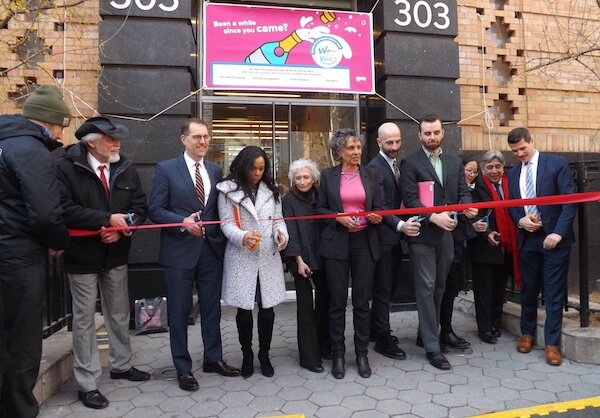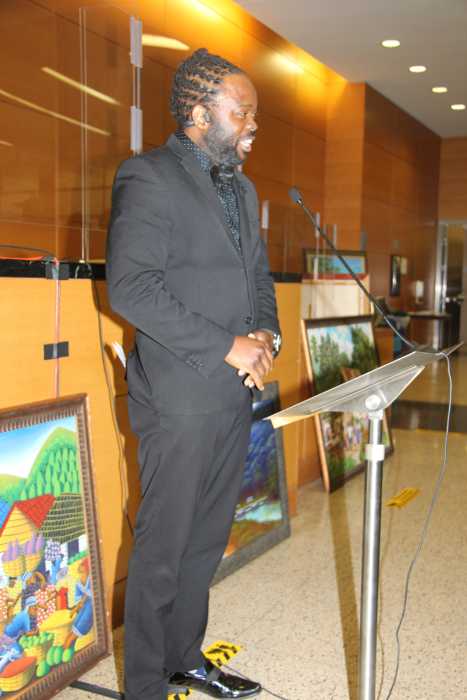Demonstrators on the steps of City Hall on April 5 protesting Mayor Bill de Blasio's delay in releasing a feasibility study on safe consumption spaces. | MIKOLA DE ROO/ HOUSING WORKS
Chanting “no more overdoses,” 75 angry New Yorkers packed the steps of City Hall on April 5 and then a smaller group staged a sit-in at the gates leading to Mayor Bill de Blasio’s office, forcing police to eject them. The demonstrators were making an emotional plea to the mayor that he release a feasibility study about safe consumption facilities that give drug users medical supervision while they are getting high.
In such spaces, users consume product they buy on the street under the watchful eye of an overdose prevention worker. Should a user slip into unconsciousness, these workers are only steps away and can administer naloxone, a public health wonder drug that reverses overdoses and restores normal breathing. There have been thousands of overdoses at such facilities in cities like Frankfurt, Sydney, and Vancouver, but nobody — as in zero — has ever died.
On February 5, Dr. Mary Bassett, the city health commissioner told a City Council budget hearing that “the public health literature is clear.” Despite that definitive statement, de Blasio has kept the health department study under wraps. Yesterday’s City Hall protesters charged that in the 59 days since Bassett’s testimony, there have been approximately 236 overdose deaths in New York.
Advocates demand de Blasio release study of facilities where drug users have medical support
Charles King, the CEO of Housing Works, an AIDS services group, opened the protest on a personal note.
“Today marks the 14th anniversary of the death of Keith Cylar, one of the co-founders of Housing Works and my life partner for some 15 years,” he said.
Then adding that he was speaking “not just on behalf of people living with AIDS and HIV, but also on behalf of people who use drugs,” King said, “Keith spoke with particular passion and urgency. He was not only a black gay man living with AIDS, he was also addicted to drugs his entire adult life. And whether it was long-term degeneration caused by AIDS or long time use of cocaine that caused his cardiomyopathy, and whether the heart attack would have happened anyway or was triggered by the crack he smoked that night, his death certificate says he died of a drug overdose. I will go to my grave knowing that if someone had been with him at that moment who knew how to intervene, he might well be standing here with us today.”
Also in impassioned remarks, Kassandra Frederique, the New York State director of the Drug Policy Alliance, said, “Safe consumption spaces are critical to saving lives. We don’t need a report to tell us what we already know, what we need is leadership.”
The mayor, she added, isn’t “leading the parade, he’s following it.”
As other speakers addressed the crowd, King and about a dozen others went inside City Hall and tried to enter de Blasio’s suite of offices. When refused at the gate leading to the mayor’s wing of the building, they sat down chanting “no more overdoses.” Police approached a limp Charles King and, with some difficulty, dragged him out of the building. Some others among the demonstrators were also carried out, while some stood up on their own. Police made no arrests either inside or out, and the rally on the steps lasted an hour and a half.
The mayor, arriving at City Hall in the middle of the demonstration, decided against walking through the protest.
Housing Works CEO Charles King being dragged out of City Hall by police after staging a sit-in. | JARON BENJAMIN/ HOUSING WORKS
In 2016, Corey Johnson, an out gay city councilmember who then chaired the Health Committee and is now Council speaker, put a $100,000 appropriation into the health department budget to pay for the safe consumption space feasibility study, at a time when overdose deaths in the city had reached 1,300 a year, more than the combined total from vehicle accidents, homicides, and suicides.
King said the report was finished in December, but the mayor has so far declined to release it publicly.
In an email, Johanne Morne, director of the AIDS Institute in the State Department of Health, said flatly, “Safe Consumption Spaces have shown success in other countries.” The idea, she continued, should be “an item of consideration” for “interventions in response to the opioid epidemic.”
In a strongly argued editorial in February, the New York Times declared the safe consumption space approach a “rigorously tested harm-reduction method” that has “proved incredibly effective at slashing overdose deaths.”
Councilmembers Mark Levine of Manhattan, chair of the Council Health Committee, and Stephen Levin of Brooklyn, chair of the General Welfare Committee, support the program.
The citywide coalition of treatment providers, medical professionals, and harm reduction activists are boiling over with anger at a delay that prevents drug users from gaining timely access to a life-saving medicine.
A drug user overdosing is helpless and depends on another person to help them regain normal breathing. Safe consumption spaces are specifically designed to meet this emergency and also allow health professionals to begin a constructive engagement with users about other means of reducing the harm caused by their drug habit.





































